July 2024 edition

Campaign aims to attract school leavers to resources sector page 5
Queensland Regional Training Awards winners crowned page 7
Unleash the Business Power Seminar and Expo page 11

July 2024 edition

Campaign aims to attract school leavers to resources sector page 5
Queensland Regional Training Awards winners crowned page 7
Unleash the Business Power Seminar and Expo page 11
The GasFields Commission Queensland has been rebranded as Coexistence Queensland with an expanded remit of addressing Queensland’s diverse energy and resources landscape.
The Queensland Parliament passed legislation last month to enact the changes, which reflect the evolving needs of the State’s energy transition and emerging challenges for communities.
Coexistence Queensland chief executive officer Warwick Squire said the changes marked a significant milestone for the organisation.
“For over a decade, the GasFields Commission Queensland has been well respected for its experience in managing and improving sustainable coexistence in the onshore gas space,” Mr Squire said.
“As the energy landscape transforms, new coexistence opportunities and challenges are emerging across the state.
“This makes our rebranded organisation – Coexistence Queensland – well placed to
Fresh data from the National Centre for Vocational Education and Research shows building and construction apprenticeship commencements have fallen 22 per cent in the year to December 2023.
Only 41,935 people commenced a building and construction-related apprenticeship in 2023, down from 54,035.
Master Builders Australia has released the Future of the workforce: apprentices in building and construction report, which shows it will take a village to ensure Australia attracts and retains our next generation of trade apprentices.
The report highlights some of the barriers impacting the industry’s ability to attract and retain apprentices and puts forward a holistic list of recommendations to reverse this trend.
“Despite a sizeable workforce of over 1.35 million people, the industry is facing acute shortages with an annual exit rate of 8 per cent, of which we are currently only replacing half of that rate,” chief executive officer DenitaWawn said.
“Prolonged construction labour shortages will lead to a $57 billion reduction in Australia’s GDP over the next five years.
“The role of improving our domestic pipeline of workers is critical to overcoming the housing crisis.
“For decades, we have seen the cultural erosion of trade apprenticeships with students being pushed towards the university system.”
Telephone: 07 4863 5050
Address: 5-9 Hempenstall Street, Kawana, QLD 4701
EDITORIAL
Breanna Lloyd Journalist
E: breanna.lloyd@CQToday.com.au
Matthew Pearce Journalist
E: matthew.pearce@CQToday.com.au
ADVERTISING
Cheryl Altouvas Advertising Sales
E: cheryl.altouvas@GladstoneToday.com.au
Cindy Unwin Advertising Sales
E: cindy.unwin@CQToday.com.au
Sherrie Ashton Advertising Sales
E: sherrie.ashton@CQToday.com.au
Kate O’Connell Advertising Sales
E: kate.oconnell@CQToday.com.au
work with the energy and resources industries, and the communities they operate in.
“Coexistence Queensland will provide educational tools and resources to landholders and communities to help them understand industry, and we’ll continue to act as an ear to the ground to guide government and industry on what community needs.
“We pride ourselves on leading, by bringing everyone into the same room to collaboratively resolve issues and achieve balanced economic, environmental, and socially-responsible outcomes.
“It’s about listening to locals, engaging with a broad range of stakeholders, and really understanding their priorities.”
Coexistence Queensland will maintain its status as an independent statutory body and will seek input from a broad range of stakeholders on where it can have the most impact in its initial phase.
The organisation does not investigate complaints, mediate, regulate, offer legal
advice or counsel, nor is it a decision-making body.
Coexistence Queensland chair John Anderson said transformational community engagement and collaboration are the foundation stones of the organisation’s work.
“Collaboration helps build social licence by building and maintain landholder and community buy-in, ensuring development occurs in a socially responsible and sustainable way, with the interests of community at its core,” Mr Anderson said.
“This concept is not new – First Peoples ancestors understood the delicate balance between using and preserving natural systems and resources through passing on knowledge and traditions of stewardship between thousands of generations. We understand that sustainable coexistence is not a destination – it is a journey.
“This journey calls us to practice shared stewardship of our ancient precious lands, winds, and waters where the benefits of socially and culturally-aware industries are ac-
cessible to, and enjoyed by all – Traditional Owners, landholders, local businesses, and the broader community.
“As we navigate the complexities of new ways of doing business, let’s draw from shared knowledge in co-creating pathways tohealthandprosperitywherecommunities play a lead a place-based role in transformational change, and resource and energy sectors extraction and production approaches contribute to harmonious relationships.”
Mr Squire said Coexistence Queensland will continue the legacy of the GasFields Commission Queensland.
“We will continue the work of the GasFields Commission Queensland in playing a key role in helping facilitate responsible industry development, and ultimately sustainable coexistence,” Mr Squire said.
“Coexistence is a shared responsibility –we must work together to successfully navigate the new coexistence challenges and opportunities facing Queensland’s energy and resources landscape.”

and Cap-
will continue flying
for three more years as ‘Lift Off Partners’.
The mine will fund $30,000 annually over the three years, ensuring CapRescue can continue to offer approximately 300,000 Central Queensland residents access to lifesaving emergency helicopter rescue services.
CapRescue operations manager Kirsty Wooler was delighted to be extending the relationship.
“Our lifesaving rescue service relies on partners likeYarrabee Coal.Their generosity and dedication to supporting us financially helps us take off every day to save lives over Central Queensland,” she said.
“We are an essential service that operates 24/7, 365 days a year, free of charge to people in the Capricorn region.
“We are grateful for Yarrabee Coal’s financial assistance for another three years. It enables us to continue flying and making sure that no one is left without critical assistance during emergencies.”
CapRescue is a community-based, notfor-profit registered charity that plays a critical role in Central Queensland by rapidly deploying medical and rescue teams to major accidents, workplace incidents, and inter-hospital transfers.
Since its inception in 1996, it has saved

more than 10,000 people across an expansive area of over 350,000 square kilometres.
Yarrabee Coal operations manager Mike Priestly proudly renewed and strengthened the agreement.
“We recognise that every day the CapRescue team respond to life and death situations and on one of those occasions it may be one of our people or their friends or family who need assistance,” he said.
“Continuing to partner with such a vital community service aligns with our mission to make a positive impact on the communities where we operate and prioritise the health and wellbeing of our people.”
The donation was part of the Yancoal Yarrabee Community Support Program, which aims to make a positive difference in the local community and to the lives of the people who work and live in the areas it operates.
The State Government has committed $80 million to sponsoring thousands of Queenslanders with free qualifications, paid traineeships, and putting them on a path to employment.
Funded by progressive coal royalties, up to 15,000 vulnerable jobseekers will be given an opportunity with communitybased not-for-profit organisations to get on the job training through the Skilling
Queenslanders forWork program.
The first round of funding in 2024-25 will invest $44.6 million to open doors for over 5,500 job seekers, who may be experiencing social isolation, learning difficulties or mental health challenges, to find meaningful work through our Skilling Queenslanders forWork initiative.
Across 94 organisations and 166 projects statewide, jobseekers will gain qualifi-
cations and real-world experience across a range of priority industries including construction, education, retail, community services, health, and hospitality.
Training and Skills Development Minister Lance McCallum said the program provides a beacon of hope and opportunity for some of the most vulnerable Queenslanders.
“We know the cost-of-living is putting
pressure on Queenslanders - this initiative provides essential support to help people secure ongoing employment to improve their livelihoods,” he said.
“The new Miles Labor Government knows that good jobs change lives – and low unemployment isn’t an accident –deliberate decisions like funding Skilling Queenslanders for Work properly at $80 million a year make a real difference.”`
Hughenden, in the Flinders Shire, has officially become the heart of Powerlink Queensland’s CopperString 2032 as construction kicks off on North Queensland’s largest regional development project.
Work started on Tuesday, 9 July, on the CopperString projects’ first and largest workforce accommodation site which will house those charged with building the 840km high voltage transmission line which will unlock world-class renewable resources and critical minerals.
ATCO Structures will deliver the workforce accommodation which is due to be completed by early 2025.
The workforce accommodation will house up to 550 construction workers at its peak. These workers will construct a nearby substation and progress early stages of the transmission line development heading west from Hughenden out to Mt Isa.
Construction includes site preparation and civil works, as well as installation and maintenance of accommodation quarters over the site’s five year life span.
Since acquiring the project, Powerlink Queensland has powered on with progress and recently announced the purchase of significant equipment critical to the delivery of the project, including shunt reactors, transformers and high voltage powerline.
A 100-strong project team has also been established, alongside Joint Venture partners UGL and CPB Contractors, with all detailed design on the transmission corridor well underway.
At a historic ceremony at Hughenden this week, Powerlink was officially welcomed by Traditional Owners, the Yirendali People. This was the first time in more than 50 years some of the remaining elders have returned to their Country, made possible by CopperString.
Premier Steven Miles said Queenslanders deserved cheaper, cleaner and more reliable energy.
“That’s why my government is embarking on the biggest ever expansion to the state’s publicly owned energy system,” he said.
“CopperString will be the catalyst for transforming Queensland’s North and North
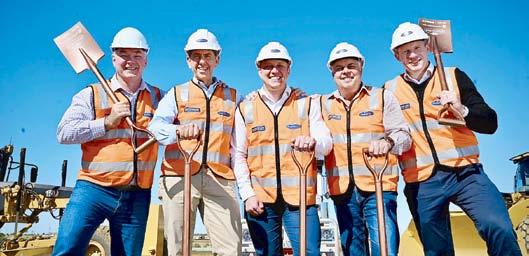
West – opening up mining opportunities, creating more jobs and unlocking critical minerals which will be essential in developing renewable technologies.
“This is the start of a long and exciting future for the region and our state.”
Work on the high-voltage transmission line is due to start mid-2025 from Hughenden, travelling west towards Mount Isa. Once complete, work will then start on the Eastern portion of the line from Hughenden back to Townsville.
Construction on workforce accommodation at Richmond will start in September 2024.
Deputy Premier Cameron Dick said CopperString 2032 lied at the heart of Queensland’s economic transformation.
“By connecting the mineral wealth of our state’s north-west to Townsville’s manufacturing precincts and port, we are creating
the opportunity for more Queensland minerals to be processed in Queensland, creating skilled jobs in new industries,” he said.
“We are also making it easier for industrial-scale renewable projects right across Queensland’s north to feed into the national grid, helping deliver more affordable, renewable energy.”
Energy Minister Mick de Brenni said CopperString would supercharge North Queensland jobs, industry and economic future.
“The renewable energy transition presents the biggest jobs opportunity our state has ever seen, and with the majority of Queensland’s clean economy jobs based in regional Queensland, towns like Hughenden will be some of the first to benefit,” he said.
“We’re powering ahead with this transformational project, and with the kickoff of construction on workforce accommodation, Hughenden, and the Flinders Shire can look
forward to a big boost in economic opportunity as the central hub for about 500 workers in clean economy jobs.”
Powerlink chief executive officer Paul Simshauser said CopperString would be calling Hughenden home for the next five years.
“This is a significant milestone for this project marked at a historic ceremony in Hughenden today, and is testament to more than twelve months of hard work to get the project to this stage by the CopperString project team,” he said.
“It was a personal highlight to see the meaning of being back on Country to the Yirendali People, a clear indication that our team are committed to respecting local communities and building a lasting legacy for generations.
“We are proud to be building the future of North Queensland, starting right here in Hughenden.”



The Queensland Resources Council held a day of key industry events in Emerald last month, celebrating and promoting Indigenous Employment in the resources sector, and the importance of regional communities to the state’s resources sector.
QRC chief executive officer Janette Hewson said Emerald was an ideal venue to host the events.
“We are extremely proud to be hosting QRC’s Indigenous Business Forum which promotes new employment and business opportunities for Aboriginal and Torres Strait Islander people and companies across Queensland,” Ms Hewson said.
“Thanks to support from sponsors and QRC members Jellinbah Group, Thiess and Coronado, over 100 people attended the forum to learn about two new QRC Indigenous Practitioner Guides on Employment and Training, and Procurement.
“The guides will assist both resources companies and Indigenous organisations to support and promote new economic and social opportunities for Aboriginal and Torres Strait Islander people and companies within the industry.”
The resources sector is the biggest private sector employer of Indigenous women and men in Queensland and new figures released at the forum revealed the number is growing.
“In the last financial year, thanks to support from our member companies, Indigenous participation in the Queensland resources sector workforce increased from 5.3 per cent to a new record high of 6.4 per cent,” Ms Hewson said.
“Thirty-one per cent of them are women compared to the 22 per cent average across the whole workforce.

“These are well-paid jobs providing good incomes and livelihoods to people living in regional and remote communities in Queensland.
“It was also very encouraging to see resources companies increase their spend with Indigenous suppliers, contractors and local businesses from $93.8 million to $142.5 million.”
An Indigenous Student Experience was also facilitated as part of the forum, with 16 Aboriginal andTorres Strait Islander students from Emerald, Blackwater and Clermont state high schools and Marist College at the Outback Exploratorium to hear from community Elders and industry professionals.
“The students had a full day where they gained a greater understanding of the role cultural heritage assessments play in mining operations and potential for study in this area through the UQ Skills team,” Ms Hewson said.
“The day provided the students with a chance to connect with resource industry professionals and identify potential employment/study pathways to be part of the resources future in this region.”
A Resources Roundup rounded off the QRC’s day in Emerald, bringing local community, business and resources sector representatives together, sponsored by Kestrel Coal Resources.
“The Roundup was a great opportunity for local community and business leaders to speak with resources sector representatives about future local plans and opportunities in the industry,” Ms Hewson said.
“Latest QRC figures revealed the resources sector contributed $2.7 billion to the Central Highlands Local Government area last financial year and supported more than
12,600 local jobs.
“The QRC values its partnerships with regions like the Central Highlands, where resources companies spent $1.1 billion on purchases from 682 local businesses and supporting 171 sports clubs and charities,” Ms Hewson said.
“The Roundup was an opportunity to highlight to the local community the threat to local jobs and economic benefits from the Queensland Government’s decision to impose the world’s highest coal royalty tax rates.
“We again call on the State Government to work constructively with the industry to reach a fair and balanced royalty regime that encourages investment and protects local jobs in regions like the Central Highlands.”
MORE PHOTOS FROM QRC’S VISIT TO EMERALD - PAGE 16
Workers facing an uncertain future after an underground coal mine fire erupted will continue to be paid until the end of August.
Operators of Central Queensland’s Grosvenor mine said they were considering redeploying staff to other sites to reduce anxiety created by the blaze.
Authorities have continued to seal ventilation shafts as they battle the Moranbah mine fire which started when methane gas ignited at the weekend.
No one was injured at Queensland’s largest underground coal mine operated by Anglo American.
However,thesite-whichhas1400work-
ers - is expected to be closed for months.
In a bid to ease uncertainty, Anglo said earlier this month workers would continue to be paid until August 31.
It marked the third time Anglo had extended a payment deadline for workers.
Anglo’s Australia chief executive officer Daniel van der Westhuizen said it was also looking at potential deployment opportunities available for impacted workers at other Queensland sites as well as NSW mines.
“This commitment has been made possible through our industry-first working group, which we’ve established with senior representatives from all unions covering

our operations in Queensland,” he said in a statement.
“We’ve brought this group together to collaborate, create continuous job opportunities and minimise uncertainty for the workforce affected by this incident.
“Together, these initiatives reflect and reinforce our commitment to providing ongoing certainty for our workforce and ensure safety and stability of Grosvenor.”
Mr van der Westhuizen said “significant progress” had been made in their battle with the blaze that has burned since June 29.
Uncertainty had also been caused by Anglo’s decision to sell their Queensland
coal mines as part of a major makeover by the London-based mining company after it held off a takeover bid from rivals BHP.
Local mayor - Isaac Council’s Kelly Vea Vea - said the Grosvenor workforce had “been through a lot” but was trying to stick together.
She said the mine was a“vital part of the community’s fabric”.
“It’s essential to recognise the resilience and strength of our community,” Ms Vea Vea said.
“Together, we can navigate these uncertain times and emerge stronger on the other side.”


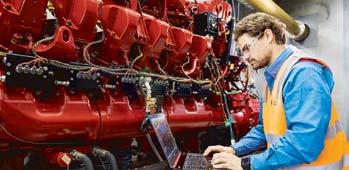
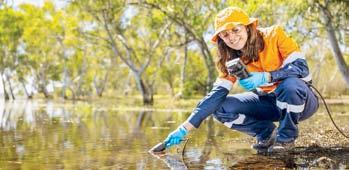
Central Queensland school leavers entering the minerals and energy sector are doing so because they want a career that offers lifestyle flexibility, a job that makes a difference and offers financial rewards which can help them get ahead.
The ‘Shape Your Future, Innovate Our World’ digital media campaign by the Queensland Resources Council is based on research into career motivators for Gen Zs and shares the stories of young people enjoying the lifestyle, opportunities to contribute to a decarbonised future, and the rewards the resources industry can offer.
Gladstone’s Maddy Hall is one of the featured youth now working as an operations technician at ConocoPhillips’ APLNG Curtis Island facility.
“My role ... is to monitor the safe operation of the live plant and ensure equipment is running within design specifications,” she said.
“I help produce liquified natural gas by monitoring, maintaining and controlling the different equipment and processes that happen on site.
“Hundreds and thousands of values and components and machinery need to be operated at the same time for us to produce LNG.
“If we don’t do this correctly, machinery can run not optimised which reduces our energy efficiency.”
QRC chief executive officer Janette Hewson said the latest campaign was developed to excite and entice young people into joining an industry which would support them and provide unique opportunities for career development.
“The resources sector is a powerhouse for Queensland which is going through an exciting period as we continue our sustainability and decarbonisation improvements and support Queensland and the world to reach net zero,” Ms Hewson said.
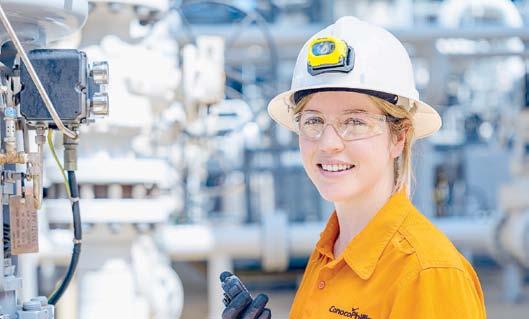
“We want the ideas and passion of bright young minds to help us on that journey.”
“From engineers, electricians and environmental scientists – we want to continue to attract talented young people in different fields to be a part of our future workforce.”
Ms Hewson said there was a skills shortage in the resources sector and the attraction of young people at the start of their career was a critical part of the solution – benefit-
ing both the employee and employer.
“Resources companies are making significant investments in their graduate and apprenticeship employment programs so they can give Gen Zs a great start to their working life,” she said.
“They will also get the reward of playing a part in new innovations and a pay packet to match that will help them reach their financial goals.”
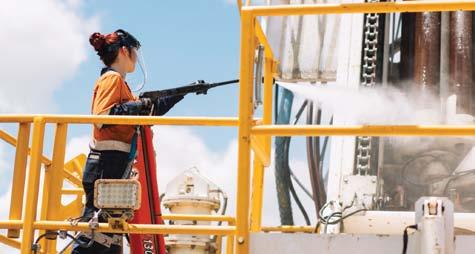
The
The LNP has pledged $61.1 million for a new state-of-the-art TAFE Excellence Precinct at CQUniversity’s North Rockhampton campus, should they win 26 October’s state election.
The TAFE Excellence Precinct will include a trades training centre, a horticultural centre as well as training facilities for metal fabrication, air-conditioning, refrigeration hospitality, IT, visual arts, hairdressing and beauty.
The precinct will see the existing Canning StreetTAFE campus relocated to the new Excellence Centre, with the site going toward delivering support facilities for the Rockhampton Base Hospital.
The deal will also secure 27 hectares of surplus land from the university, which the Shadow State Development tMinister Jarrod Bleijie said the LNP would prioritise for housing, as part of its plan for one million homes by 2044.
Mr Bleijie said the investment would help addressboththehealthandhousingcrises,as well as delivering a plan to secure the skilled workers needed for Queensland’s future.
“The LNP will deliver easier access to health services, more housing and more tradies with this $61 million investment in Rockhampton’s future,” he said.
“Rockhampton has been crippled by a lack of housing, a lack of skilled workers and a hospital crumbling under Labor’s failure to resource and run it.
“Queenslanders want change and the LNP has the Right Plan to deliver it.”
CQUniversity’s vice-chancellor and president, Professor Nick Klomp said the university had been progressively consolidating its VET delivery from the City Campus to the North Rockhampton campus since the merger with CQ TAFE 10 years ago.
“Completing this project will see all VET and Higher Education courses delivered from a single campus on North Rockhampton to supercharge our local workforce and create seamless training pathways for our students,” Prof Klomp said.
“Once complete, this project will deliver hundreds of extra skilled workers – more tradies on workshop floors across industry, more construction workers building desperately needed houses and more skilled locals to fill much needed roles in industry and our small business community.
“Additionally, with certainty over our Rockhampton campus footprint, consolidation will also allow CQUniversity to open up surplus land on our North Rockhampton campus for housing development.
“This land will provide space for hun-
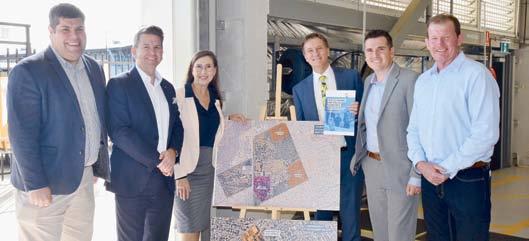
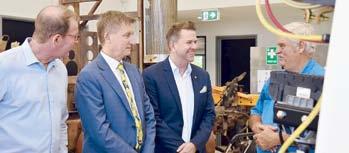
dreds of new houses and is located alongside the path of the Rockhampton Ring Road as well as the start of the Northern Growth Corridor.
“Finally, once CQUniversity has vacated the City Campus site on Canning Street, that land will be returned to the Queensland Government for future use.
“While that site has served CQUniversity well over the past decade, it has become increasingly underutilised as various VET courses have been brought over to North Rockhampton.
“Located only 250m from the current Rockhampton Hospital, the site is of strategic importance to the community, and presents an opportunity to explore the expansion of health services for the region.
LNP candidate for Rockhampton Donna Kirkland said delivering easier access to health services for the Rockhampton community was a priority for the LNP government.
“Rockhampton is ground zero for the Queensland Health Crisis and deserves better than the 48.6 per cent ambulance ramp-
ing rate,” she said.
On the other side of the political fence, the ALP’s Training and Skills Development Minister Lance McCallum said the LNP’s pledge “unfunded electioneering”.
“The LNP said they’ll reduce debt and deficit, that means any spending commitment they make will be paid for by cuts,” he said.
“What are they going to cut to fund this promise? If they can’t say, it won’t happen.
“The last time the LNP were in government they cut 80 Central Queensland TAFE workers and closed TAFES around Queensland.
“Now they want to hand back billions to mining billionaires meaning they will have to deliver even more cuts to TAFE.”
Housing Minister Meaghan Scanlon was similarly scathing.
“If the LNP were serious about housing in Queensland, then Jarrod Bleijie, Nigel Hutton and Donna Kirkland should have asked Peter Dutton at the LNP conference to stop blocking the Help to Buy scheme and 8000 Queenslanders from buying their own home,” she said.
Prof Klomp said CQUniversity would continue discussions with the Queensland ALP State Government toward securing a bipartisan commitment in the lead up to the election.
Ergon Energy has opened its apprentice intake, offering game-changing opportunities for 185 new starters to join Queensland’s electricity distribution companies.
This year, Ergon Energy Network and Energex are recruiting for 61 locations; from the Gulf to the Gold Coast, and west across Outback Queensland. Apprenticeships are being offered across five trade disciplines - distribution linesperson, electrotechnology electrician, communication technician, transmission linesperson, and mechanical fitter.
Ergon is recruiting for 44 depots across regional Queensland including Gladstone, Bundaberg, Biloela, Blackall, Hervey Bay, Emerald, Clermont, Monto, Rockhampton, Roma, Springsure and Moranbah.
In South East Queensland, Energex is seeking apprentices at 17 depots and sites at Beaudesert, Berrinba, Burleigh Heads, Caboolture, Cleveland, Cooroy, Gatton, Geebung, Greenslopes, Gympie, Landsborough, Maroochydore, Oxley, Raceview, Southport, Stafford, Stapylton
Full details of roles, locations, the application process, and “day in the life” videos
introducing the different trades are available on the Ergon Energy Network and Energex websites
Candidates must be aged at least 17 at the time of the apprenticeship starting in mid-February 2025.
In addition to training, competitive salaries, and supplying all tools, uniforms, course fees and textbooks, there are additional generous allowances for those considering a career outside major cities. Depending on where apprentices are based, those in rural, regional and remote Queensland may be eligible for:
· Up to $25,000 per year zone allowance (for designated locations outside major cities)
· Up to $7000 per year locality allowances
· Up to $24,000 per year in housing support, where approved
· Up to five additional leave days per year to enable travel to and from holiday destinations.
The Class of 2025 will join nearly 560 apprentices currently at various stages of their trade apprenticeships at Ergon Energy and Energex.
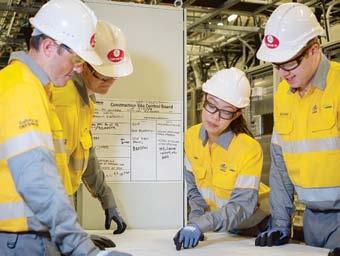
Gladstone’s Tyler Gscheidle was crowned Central Queensland’s apprentice of the year at the 2024 Queensland Training Awards CQ Regional Final.
Gscheidle, now a qualified carpenter with Harbour City businessWerry Building, took home the prized Harry Hauenschild award during the event held at the Gladstone Entertainment and Convention Centre on Saturday, 6 July.
His journey from mentee to mentor has come full circle as he now guides the company’s next crop of apprentices.
Gladstone MP Glenn Butcher said Gscheidle was a worthy winner of the top honour.
“A huge congratulations to Gladstone local Tyler who took out the Harry Hauenschild Apprentice of the Year award for his Certificate III in Carpentry,” Mr Butcher said.
“Gladstone is Central Queensland’s trade heartland, so it was great to see this year’s awards hosted in our proud industrial city and supported by the new Miles Labor Government.
“Well done also to Emerald Neighbourhood Centre and Central Highlands Regional Council, which took out CommunityTraining Initiative of theYear and Large Employer of theYear - this shows training is strong in our regions.”
Tyler will now vie for the state honour against the other regional winners (Metropolitan, Tropical North Queensland, Darling Downs South West, South East, North Queensland and North Coast) in September.
So too, Johnson’s 4WD in Rockhampton, acclaimed as the Small Employer of the Year as recognition for their great work developing the skills of their apprentices and staff to deliver high-quality four wheeldrive services and repairs.
Representing the business at the prestigious event were Nyree Johnson, Ethan Milner, and Chloe Keller, accepting the award on behalf of the entire Johnson 4WD team.
The accolade celebrates small businesses that demonstrate exceptional achievements in providing nationally recognised training to their employees, fostering a culture of continuous improvement and skill development.
“Winning this award is a testament to our dedication to employee development and training,” Nyree Johnson said.
“We believe that investing in our people is the foundation of our success, and we are thrilled to be recognised for our efforts.”
Other Central Queensland winners included Theodore’s Jacqueline Grundy, who was honoured with the Vocational Student of theYear award and Rockhampton’s Chloe Cameron, the Bob Marshman Trainee of the Year.
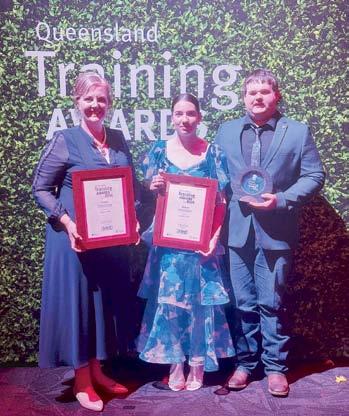
The 63rd edition of the regional finals showcased the great work in vocational education and training (VET) across the Sunshine State, with categories for apprentices, trainees, vocational students, teachers and trainers, community training projects and employers.
With almost 750 statewide nominations this year, the selected regional finalists represent the excellence, hard work, and dedication evident in Queensland’s highperforming training system.
Training and Skills Development Minister Lance McCallum said the awards provide the ideal platform to highlight the top performers in training and demonstrate the transformative power of skills.
“The Miles Labor Government is backing more locals like them by funding one million training places for Queenslanders,
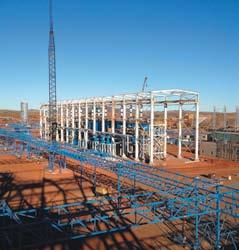
easing cost-of-living pressures for those who want to train, upskill, reskill, and pursue careers in the state’s priority industries,” he said.
“This strategy is not just real cost of living relief now, but a chance at a better life, with better pay and a better job, helping grow our economy right across the state.”
Full list of Central Queensland winners: Individual award categories
· Harry Hauenschild Apprentice of theYear — Tyler Gscheidle, Certificate III in Carpentry, Gladstone
· Bob Marshman Trainee of the Year — Chloe Cameron, Certificate III in Water Industry Operations, Rockhampton
· Vocational Student of the Year — Jacqueline Grundy, Certificate II in Timber and Wood Product Operations, Theodore
· Aboriginal and Torres Strait Islander Stu-


dent of the Year — Bevin Querro, Certificate III in Automotive Electrical Technology, Mackay
· School-based Apprentice or Trainee of the Year — Chelsea Bostock, Certificate III in Hairdressing, Mackay
· Equity Student of the Year — Denise Cotter, Certificate III in Early Childhood Education and Care, Sarina
· VET Teacher or Trainer of the Year — Gareth Hartley, MTA Institute, Mackay Organisation award categories
· Community Training Initiative of the Year — Emerald Neighbourhood Centre’s Get Set for Work program
· Large Employer of the Year — Central Highlands Regional Council
· Small Employer of the Year — Johnson’s 4WD, Rockhampton
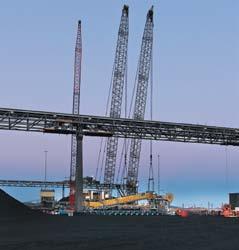
By Gregor Mactaggart
Central Queensland is the corner of the Sunshine State’s renewable energy revolution.
Five new solar and wind farms across the region look set to start sending electricity to the grid by the end of 2026.
Construction is underway on the $500m Aldoga Solar Farm, located 20km northwest of Gladstone.
The solar farm will feature up to 820,000 solar modules with the capacity to produce 480 megawatts at its peak.
Premier Steven Miles dropped by to take a closer look at the progress in April, with the project strategically situated within the Gladstone State Development Area (SDA) on land owned by Economic Development Queensland (EDQ).
EDQ signed a development lease with leading renewable energy company ACCIONA Energia.
Mr Miles said the State Government was committed to increasing renewable energy supply, generating jobs and supporting economic growth.
“On my first day as Premier, I announced that my government would lift Queensland’s ambition on climate action - and reduce our emissions by 75 per cent by 2035 - to strengthen our economy and create jobs,” he said.
“Our target along with the Queensland Energy and Jobs Plan, gives big business the confidence that the Sunshine State is the best place to invest in renewables.”
The Aldoga Solar Farm is pinpointed to offer $150 million in local procurement opportunities and deliver up to 350 jobs during
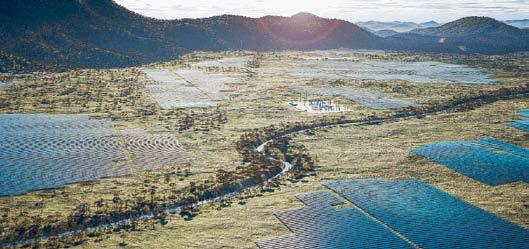
the construction phase.
The facility is scheduled to be operational by mid-2026 and operate for 30 years.
All of the electricity produced at Aldoga will be supplied to Stanwell Corporation’s proposed Central Queensland Hydrogen project (CQ-H2) under a Power Purchase Agreement.
CQ-H2 is the state’s largest renewable hydrogen project, which aims to deliver renewable hydrogen through different carri-
ers to Japan and Singapore, as well as supplying large domestic customers in Central Queensland.
ACCIONA Energia managing director
Brett Wickham said it is an exciting time to be in the renewable energy space.
“Projects like Aldoga will help transition our energy system, while providing the employment, training and procurement opportunities regional communities are asking for so they can take advantage of this booming industry,” he said.
“The Queensland Energy and Jobs Plan, great partners in Stanwell and Economic Development Queensland, and some of the best renewable resources in the country are why we want to keep building projects here.
“ACCIONA Energia is committed to supporting the local community in the areas around our projects. We invest in the community to build skills and capability that leave a lasting legacy to be proud of.”

APPROXIMATELY 20km north-west of Gladstone
is the project owner, developer, constructor and operator
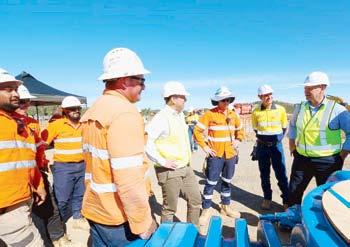
That includes ACCIONA Energia’s community benefits program which will provide $120,000 in annual funding to local initiatives, including scholarships with CQUniversity, small grants and legacy projects. Four wind farm projects are blowing in the wind.
EDF Renewables’ Banana Range, located 20km west of Biloela, is expected to start construction in 2025 and be operational in 2026. When built it will produce 230 megawatts from 38 wind turbines.
Boulder Creek, located 5km west of Mount Morgan, is being developed by Aula Energy and expected to comprise up to 60 wind turbines, with a capacity of up to 372 megawatts when fully operational.
Neoen Australia’s Mount Hopeful, located 50km south of Rockhampton, 60km north of Biloela and 70km west of Gladstone, has been approved for up to 97 wind turbines with the potential for battery storage. The final project capacity is expected to be around 350 megawatts. Squadron Energy’s Clarke Creek Wind Farm, 150km northwest of Rockhampton, achieved a milestone in June with the successful installation of the 25th turbine.
“We are working with around 15 Queensland businesses to deliver this project, with about 350-400 workers onsite daily,” Clarke Creek Wind Farm construction manager Wayne Mills said.
“It’s fantastic to be working with a range of local contractors to deliver this significant

project for Queensland’s energy transition.”
Once complete, the 450 megawatt wind farm, consisting of 100 turbines, will produce enough energy to power around 330,000 homes. The project has injected $110 million into the Central Queensland economy during the construction phase.
The State Government has established a new independent technical advisory board to oversee the renewable transformation.
The new board, led by Queensland professional engineer Leanne Bond, will provide critical advice to the State Government and Energy Minister.
“To deliver the energy transition we need the best of the best,” Energy and Clean Economy Jobs Minister Mick de Brenni said.
“These energy superheroes will help the Miles Government deliver on its nation leading energy plan, providing independent advice and ensuring we stay on track as we decarbonise.
“I’m looking forward to working closely with the new board, as we continue our energy transformation and work towards delivering cheaper, cleaner energy for generations to come.”
Renewables are also a focus for the Federal Government, which put forward its Future Made in Australia policy to parliament.
Under the policy $22 billion would be spent over the next 10 years to revive the nation’s manufacturing base, particularly in areas such as renewable energy and critical minerals, setting the country up for decades, Prime Minister Anthony Albanese said.
“In areas like green hydrogen, we have a comparative advantage going forward, and indeed as well, as the world moves to a netzero economy, there is nowhere you would rather be than Australia,” he said.
Opportunity does knock for the next generation when it comes to employment, something that will be highlighted when the Careers for Net Zero Fair, Queensland Roadshow visits Gladstone next month. The fair will have representatives from Stanwell Corporation, ACCIONA Energia, Akaysha, Alpha HPA, CQUniversity, CS Energy, Powerlink, Squadron Energy, Windlab and more.
Clean Energy Council regional director of policy and impact Tracey Stinson said there will be around 30,000 jobs needing to be filled over the next 10 to 20 years in Central Queensland alone.
“We know we have a lot of roles to fill, and some people don’t really know what types of careers renewables will offer,” she said.
“The renewables industry is so diverse; it presents an opportunity to jump around.”
MORE ON THE CAREERS FOR NET ZERO FAIR - PAGE 15
There is no doubt that the price of electricity will continue to go up.
76% of Queensland’s power is still produced by burning coal, and although the wholesale price for coal has come back a lot, it is still up over 90% since 2020!
That means eventually that must be passed on to the consumer. Forget the funny money, (our money), the Governments are giving us. They cannot keep doing this forever! They (we?) are massively in debt!
The Tariff 11 price is already over 34 c per kWh. The cost for you to produce your own power is approximately 7.6 cents per kWh over 10 years. Or 3.8 cents per kWh over 20 years!!! Why keep sourcing your power from the grid? Get solar now, while it is still affordable!
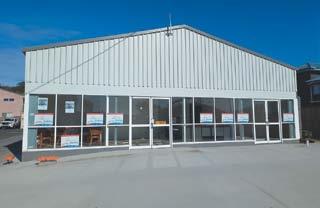

Solar Power Gladstone will shortly be able to demonstrate three different inverter/battery combinations side by side.
We are moving to bigger and better premises at 35 Toolooa Street within a few weeks, right next door. Here you will be able to see the three systems side by side. We hope to have our grand opening on Saturday the 10th of August from 10am -1pm, complete with an outside radio broadcast

CQUniversity earlier this month celebrated 10 years since it merged with CQ TAFE, establishing Queensland’s first and only dual sector university and becoming the official public provider of TAFE in Central Queensland.
A decade on from the history-making merger, CQUniversity has expanded its vocational and higher education study options and now delivers 250 plus courses from Certificate to PhD level to more than 30,000 students.
The university has also built new partnerships with industry and invested more than $80 million in new and upgraded training facilities in Emerald, Gladstone, Mackay and Rockhampton.
Member for Gladstone and Manufacturing Minister Glenn Butcher said that the role of a unified education and training provider was never more important than it is now for the region.
“Gladstone is the energy heartland of Queensland, so it is vital these opportunities are available to train locals for jobs now and jobs of the future,” Mr Butcher said.
“CQUniversity as a dual sector university is supporting the local region by integrating the delivery and application of training, higher education and research to benefit established and emerging industries.
“This approach helps to secure strong future workforces and reflects the vision of the Miles Labor Government’s Queensland Skills Strategy that Queensland is a jobcreating economic powerhouse driven by skilled Queenslanders.”
CQUniversity’s TAFE offerings now include short courses and Certificate I, II, III and IV courses and apprenticeships and TAFE diplomas. Study areas include Allied

Health, Community Services, Project Management, Information Technology, Nursing, Safety, Fitness, Horticulture and Science, Trades, Business, Education and Childcare, Legal and Justice Studies, Hair and Beauty, Hospitality and Cookery andVisual Arts.
There are currently more than 11,000 students enrolled in a TAFE qualification at CQUniversity, representing approximately one-third of the University’s total student population.
CQUniversity’s vice-chancellor and
president, Professor Nick Klomp, said the merger of the University with CQ TAFE has reinforced the importance of all levels of education and training, improving pathways between different levels of study in the region.
“The merger was a history-making moment for education in Queensland as it bought together more than 140 years of combined experience in the delivery of education and training in Central Queensland,” Prof Klomp said.
“While dual sector universities had been established in other parts of Australia, it was an unprecedented step in Queensland and has revolutionised the way we deliver vocational training and higher education in the region.
“Not only have we been able to develop more streamlined pathways between different levels of study, but we have also been able to build closer ties with industry, to gain a deeper understanding of their skills and workforce needs.”
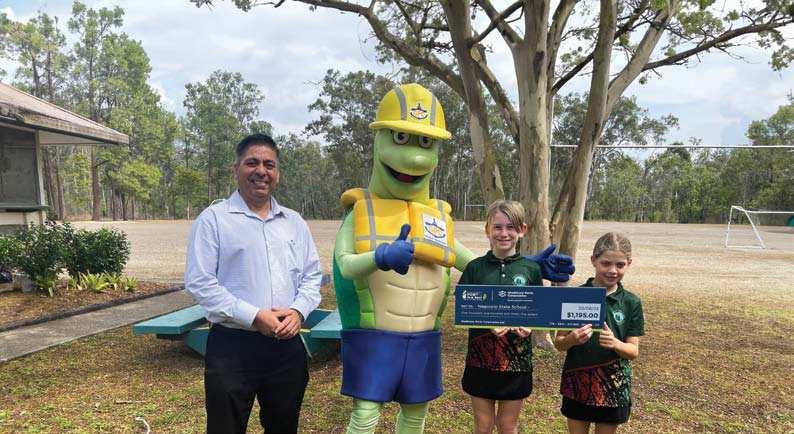
By Matthew Pearce
The Capricornia Chamber of Commerce is calling for local business people to “unleash the power” at a new seminar and expo coming to theYeppoon Town Hall.
The Harvey Norman Unleash the Business Power Seminar and Expo will be held on Thursday, 29 August.
Capricornia Chamber of Commerce membership officer Craig Gibbs, who is organising the event, said the inaugural seminar was was a rare chance for people in regional Queensland to attend the type of function that was usually only available in capital cities like Sydney.
He said the people who would gain the most from the seminar and expo would be managers, team members, small to medium size business owners and self employed people.
Attendees can attend the workshops that are the most important to them or stay for the whole day.
“People who are going into business will benefit, people who are already in business will benefit - particularly people who might be struggling to keep or even find staff,” he said.
“From a networking point of view, having 200 people in the room can be a great advantage.
“We already have mining companies and large recruitment companies who have registered.”
Special guest speakers will include Damian Morgan (sales mastery), John Hale (strategy and leadership) and Catherine Molloy (customer marketing)
“Catherine Molloy is a dynamo and is currently in the UK teaching the Poms how to provide better customer service,” Mr Gibbs said.
“In Central Queensland, our customer service rating is pretty poor.
“People don’t know what customer service is, it goes a long way past please and thank you, although they’re a good start.”
“John Hale, who has two sessions, is all about strategic planning and how we can unlock the brain to find more time in our day.
“Damian Morgan is speaking about emerging trends when it comes to marketing as well as the important role media like CQ Today, 4RO and Channel 7 play in our local ‘ecosystem’.
The expo will also feature 20 exhibitors representing fields from bookkeeping to recruitment and AI.
The Capricornia Chamber of Commerce is a not-for-profit group and Mr Gibbs said the success of the inaugural seminar would determine whether it became an annual event or remained a one-off.
“People don’t want to miss this opportunity in case it doesn’t happen again,” he said.
“Putting on an event like this costs a lot of money, even with our partners, so we need to get the house full.
“But the good news is we’re well on the way and have already sold 60 per cent of seats.”
Mr Gibbs said the business seminar would be the largest in the region for over a decade.
To register for the expo, go to events@ capricorniachamber.com.au or scan the QR code on Page 11.
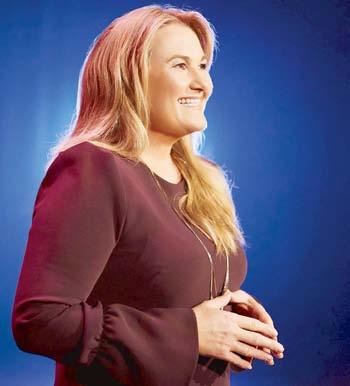





As we approach the state election, it’s crucial to bring attention to a pressing issue affecting businesses in CQ and across Queensland: the rising cost of insurance.
Firstly, we pay both GST and Stamp Duty on insurance premiums.
This effectively amounts to a tax on a tax, applied to a critical service. Insurance is not a luxury; it’s a necessity. Removing one or both of these taxes would provide immediate relief to businesses struggling to keep their doors open amidst rising costs.
A critical point recently raised by the Townsville Chamber of Commerce is the obligation for insurers to provide coverage across the entire country.
Currently, insurance companies are required to cover every part of Australia to obtain a licence.
This system, which works in parallel to a reinsurance pool, is designed to ensure a spread of risk. However, allowing insurers to cherry-pick profitable areas while neglecting higher-risk regions like Northern Australia undermines the very essence of insurance.
When the risk is spread over the whole of Australia, the profitability of the insurance industry remains healthy.
For instance, the industry saw an estimated profit of $8.2 billion from home, contents, and strata insurance across Australia over 12 years to 2018-19. However, singling
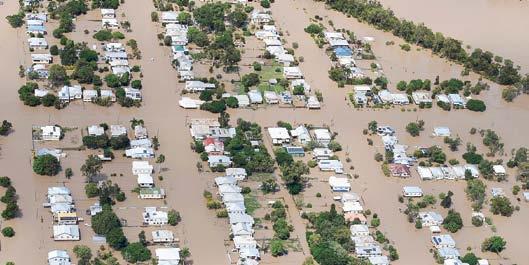
out Northern Australia as unprofitable, with a recorded loss of $856 million, highlights a significant disparity. Insurance companies exiting high-risk areas leads to a lack of coverage, driving up costs and making insurance unattainable.
To maintain a robust and competitive market, the risk of insuring in Australia must be shared equally across the entire nation.
The Townsville Chamber’s submission also underscores a market failure in North-

ern Australia. If the private sector is unwilling to provide affordable and attainable insurance, the government must step in to offer baseline coverage.
Thiswouldincludeessentialbuildingand contents insurance and public liability, akin to how healthcare is provided. A national insurer offering a baseline service would not only be profitable, as more policies would be taken out, but also ensure premium parity across Australia.
Rockhampton is not immune to these issues. We’re affected by floods, storms and fires like our friends up north.
The cost of insurance affects every business, from small family-owned operations to larger enterprises.
By removing GST and Stamp Duty on insurance premiums and ensuring the risk is spread across the country, we can create a fairer, more sustainable insurance market.

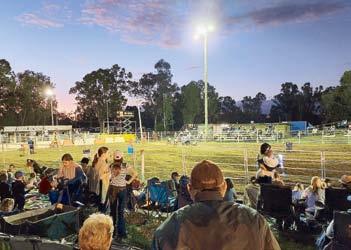



As I write this column, I can see in the distance a teenager, at the back of side-show alley, wildly waving his arms around, as if possessed by Peter Garrett’s Midnight Oil spirit. The rain is light, as the number of people walking past. I am at the Proserpine Agricultural Show, the eight of nine small country town agricultural shows that I have attended, as an exhibitor, since May.
While I feel there is little argument Agricultural Shows are not as big as they used to be, for numerous reasons, they are still very important to each community, especially the small ones, that host them.
Not just for the social connection benefits they provide, but the opportunity to tell some of their community unique story and, I believe most importantly, aid in the personal development of the local youth.
At the Alpha Show, my display was opposite the woodchopping events.
Amongst all the big guys competing, was a young solid teenager, maybe 14 years of age. Even in the handicap events, at which he started from zero, the final axeman some 30 seconds later, he finishes last by some margin. However, he keeps going until the final, breakthrough, cut is made. As the older cutters finish, one goes over to the teenager, just to watch what he is doing, and on him finishing, give advice, as both examine the texture of the log. Maybe the young guy is too young to appreciate everything that is going on, perhaps more focused on emulating his father, but the willingness to persevere, take advice, understand than comradery can coexist with competition, and do this in front of an audience, all bides well for his personal development through the tricky teenage years.
It’s not just in the competitive events, that you see this happening. In the dining room at the Proserpine, Biloela and Clermont Show, teenagers (and younger) stand beside adults, taking and preparing food orders, talk openly with their elders and willingly clean tables. Seemingly unperturbed about not being in side-show alley.
Beside the cattle yards at the Springsure Show, youth not only presented cattle for judging, they judged them too, having to explain their selections to an attentive, adult, audience. On the main stage at the Baralaba Show a local youngster sang a ‘Swiftie’ song beside the visiting headline act. School bands and local dance studios provided entertainment at the Longreach and Clermont Shows.

The active involvement of youth is purposeful, in looking to the future of their sport, club, industry and the Show.
However, the personal development of youth who just attend the Show, to be with their mates, go on a few rides, also benefit from the unique mish mash of ingredients that attracts both patrons and exhibitors to an agricultural show.
In one of the pavilions at the Biloela Show I find myself beside and opposite high school teachers.
The Art teacher with her strategically displayed prints, the music teacher with her book about her South Seas Island upbringing (Voices from the Village), another music teacher with the earrings and studs she makes, and the relief teacher with his children’s books, that combine philosophy, psychology, environmentalism, with the power of positive reinforcement.
The conversations that ensue from when the student sees their teacher than the display in front of them, are fascinating to listen too. “Did you draw these Miss, did you write this Sir, do you make these Miss?” When responded to with a yes, a conversation begins that is hard to imagine could happen in school hours. The student sees their teacher
in a different light, the teacher gets to hear what interests the student about the display and suggests ways they can cultivate their interest. I wonder how that will affect the future dynamics in the classroom, especially now the Art Teacher is informed the most mischievous boy in her class vomited after a ride on the Pendulum. Where else, but a country show, could this occur?
While Home Shows, Field Days, Beef Expo’s, pop-up and permanent amusement parks, Car Shows, Machinery Expos all take bites out of the Show, it continues. Partly because of tradition, Bowen celebrated its 141st Show (North Queensland’s oldest show), triggering a sentiment, amongst enough of the community, that their (Agricultural) Show must go on. But there is also nothing else that replicates the whole Show experience. There really is something for everyone, even the chook fanciers.
And each Show is different, similar, but no Show is a clone of another. Every community brings its own ingredient(s), like sugar cane stalks being judged at Proserpine. Or, the tag-team Stockman’s Challenge at Longreach.
Each Show though, needs to also keep innovating, and as I look out seeing that teenager still waving his arms wildly around, I
wonder if the VR headset he is wearing may be part of the necessary innovation, as costs for everyone, committees, carnies, exhibitors, patrons, keep increasing and the volunteer base of some of small country towns decreases.
The (Ag.) Show must go on, the benefits it brings to the community are way more than just a public holiday and the once-a-year dagwood dog. In a way, you can measure the health of a community by its local Show.
To all the volunteers, sponsors, exhibitors, performers, carnies, schools, and those that paid the entrance fee, congratulations, keep the tradition going, with a touch of innovation.
P.S. I must mention, what I saw at the Marlborough Show, something you would not see at the Ekka, a horse rider in his DryAs-Bone, one hand on the reins, the other behind him balancing his swag behind the saddle, coming through the entrance gate. How far had he travelled who knows, but he was going to see the Marlborough Show through to the end and then some. And the lolly drops at Baralaba and Alpha, wrapped hard boiled lollies falling from sky, it appeared to be the thing the young kids looked most forward to. I am thinking Brisbane kids would miss out on that sight too.
Students across regional Central Queensland thewesterndistrictswillhavebetteraccessto much needed face-to-face training through a new State Government initiative aimed at spreading the benefits of coal royalties to the region.
Minister for Training and Skills Development Lance McCallum said the 12-month $10 million Rural and Remote Pilot will focus on increasing the uptake of Certificate III and above qualifications for new students in 11 Central Queensland councils to meet local skills needs.
They include the Central Highlands, Banana, Barcaldine, Blackall Tambo, Boulia, Barcoo, Isaac, Longreach, Diamantina, Winton andWoorabinda local government areas.
“Weareinvestinginabrandnewruraland remote pilot so Queenslanders who are living in rural and remote communities can get the very best vocational education and training delivered in their community, which means they will recognised qualifications that will get them on to a pathway into a great career,” Mr McCallum said.
“We want to get more Queenslanders into highly paid, highly skilled jobs and that is what this will do.
“We know that face-to-face learning is the preference of both the teachers and the students, so by delivering more training in community we’re hoping to see people start a qualification that they might not otherwise have done and also improve the amount of people that are coming through to graduate.
“Whether it’s healthcare or through to hospitality and tourism, we want to see more people getting on that training and skilling pathway.”
The government is partnering with CQUniversity – one of twelve training providers in the Central Queensland region who
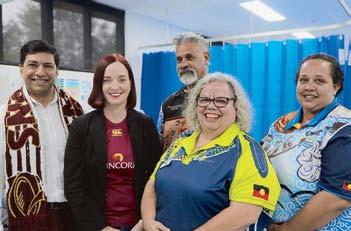
will collectively support almost 900 students to access training.
An over 20 per cent increase in the local healthcare and social assistance industry’s workforce is expected from 2021-22 to 202526, making it the industry with the largest jobs growth in the Central Queensland region.
Training will also be provided in agriculture, rural operations, hospitality, and tourism.
The pilot aims to identify if VET enrolments and completions by rural and remote students increase when training and support
is delivered locally, and to help inform future VET investment in these communities.
CQUniversity will deliver the Certificate III inCommunityServices,CertificateIIIinIndividual Support, Certificate II in Skills forWork and Vocational Pathways, Certificate III in Aboriginal and/or Torres Strait Islander Primary Health Care and Certificate III in Health Services Assistance across the Banana Shire, Woorabinda Shire and Longreach and Central Highlands Regional Council areas.
“We know that students who undertake theirtrainingathomeintheircommunityare also more likely to stay working in their com-
munity when they complete their students,” Keppel MP Brittany Lauga said.
“So, I can think of nothing better than more nurses, more skilled people working at home in our rural and remote communities.
“I’m looking forward to more nurses at the Moranbah Hospital who have undertaken their training in Central Queensland at home andthenbeingabletostarttheircareerworking in the community that they live in.
“This is going to make a really big difference to rural and remote communities, particularly in that healthcare space.”
“From Biloela to Blackall and Winton to Woorabinda, the new State Government is making our plan to subsidise training for one million Queenslanders within reach of every Central Queenslander.”
CQUniversity VET and Business Development deputy vice-president Peter Heilbuth said the educational facility was committed to increasing participation in all levels of education and training by providing access to flexible learning and teaching systems and programs, as well as tailored student support offerings.
“At CQUniversity we firmly believe that geography should never be a barrier to individuals being able to study and attain a qualification that will benefit their careers and communities,” Mr Heilbuth said.
“As a delivery partner within this pilot, we are well-placed to support students and deliver high quality training in health and community services.
“Skills within these service areas are in high need within regional and remote communities in central and western Queensland and we look forward to working with these communities to deliver these much-needed skills.”

By Karen Simmons
The Careers for Net Zero Fair, Queensland Roadshow is coming to Gladstone in August to showcase to the community the opportunities in employment coming to the region.
Clean Energy Council regional director of policy and impact Tracey Stinson was in Gladstone recently to discuss the upcoming Careers for Net Zero Fair with local business, industry, education representatives and council leaders.
Renewable energy, critical minerals and sustainable manufacturing are creating new job opportunities across Queensland, with many of those roles set to be based in the Gladstone Region and Banana Shire, concentrated in Renewable Energy Zones (REZ).
The free, all-day event will appeal to school students, school-leavers, University grads and students, current industry workers and those looking to upskill or transitioning from the coal industry.
Mrs Stinson said there will be around 30,000 jobs needing to be filled over the next 10 to 20 years in Central Queensland alone.
“So, we know we have a lot of roles to fill, and some people don’t really know what types of careers renewables will offer,” Mrs Stinson said.
“The renewables industry is so diverse; it presents an opportunity to jump around.
“It will provide opportunities for young to learn here, stay here and raise families here in Gladstone without having to move away.
“Everything is becoming electrified, so we need skills around that and how we build, maintain and operate things.
“There are a lot of mature workers - those old hands and heads - their skills are needed and can be transferred into new roles. They

come out of a very skilled environment with a great focus on safety.
“I think it’s a really multi-generational opportunity.”
Mrs Stinson shared there will jobs like engineering, technical roles, line workers, operations and maintenance of systems type roles will all be on offer.
“Even finance roles are needed for watching the energy markets, and these are wellpaid, long-term jobs,” she said.

The Reserve Bank of Australia wants to get inflation back within its two-three per cent target band by late 2025. (Bianca De Marchi/AAP)
Australia’s inflation has moved further in the wrong direction, pouring cold water over the case for near-term interest rate cuts and reviving the possibility of another hike, signalling more pain for borrowers.
The monthly consumer price index rose four per cent over the 12 months to May, above consensus forecasts of 3.8 per cent and up from the 3.6 per cent increase in April.
Holiday travel and accommodation inflation rose annually for the first time since October last year, with price growth still consistently strong across rents, new dwellings, insurance and petrol.
Yet it was the trimmed mean rising to 4.4 per cent from 4.1 per cent in April that sounded alarm bells, with Betashares chief economist David Bassanese warning the May numbers would put “huge
pressure” on the Reserve Bank of Australia.
“The May monthly consumer price index report can only be described as a ‘shocker’ and places huge pressure on the Reserve Bank to raise interest rates in August,” he said.
The monthly consumer index is not as comprehensive as the quarterly update, which is still considered the principal measure of inflation and the June edition will be crucial ahead of the next interest rate meeting in August.
A central bank assistant governor reiterated the bank’s attentiveness to upside inflation risks in a speech delivered before the monthly inflation readout and confirmed nothing would be ruled in or out in relation to its next interest rate move.
The Clean Energy Council director spoke with local businesses who were present at last week’s session showing keen interest in how they too can be a part of the coming jobs boom.
“Even local businesses want to be a part of this,” Mrs Stinson said.
“We need to make sure there are those indirect jobs that come out of these times of growth.
“I think this (clean economy) industry really needs to genuinely partner with com-
munities and embed themselves within the community.”
The careers fair will have representatives from Stanwell Corporation, ACCIONA Energia, Akaysha, Alpha HPA, CQUniversity, CS Energy, Powerlink, Squadron Energy, Windlab and more.
The Careers for Net Zero Fair will be held on Friday, 9 August, from 9am to 3.30pm at the Gladstone Entertainment and Convention Centre.















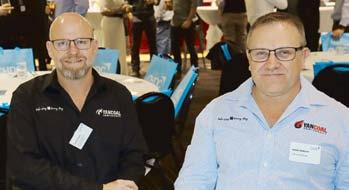
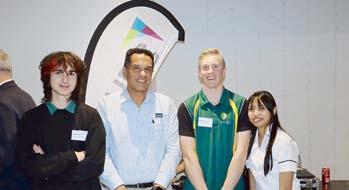
The Central Highlands Development Corporation’s major projects working dinner gave local businesspeople the chance to hear from Queensland Resources Council chief executive officer Janette Hewson and Whitehaven Coal’s managing director Paul Flynn. Photos courtesy of the Central Highlands Development Corporation.
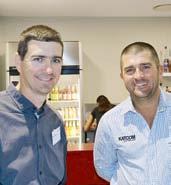
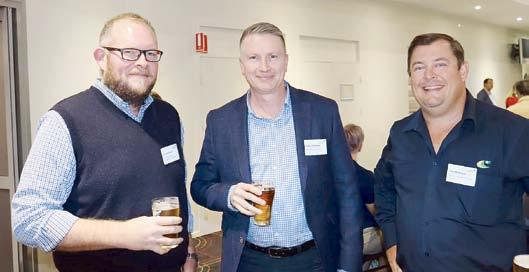
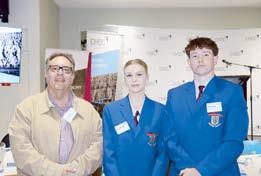
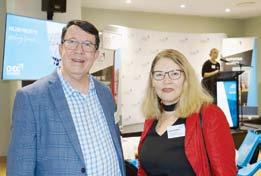


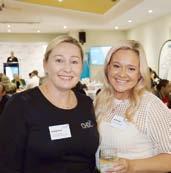

By Di Stanley
Whitehaven Coal has vowed to earn the faith of the Blackwater townsfolk, champion a residential workforce, and prove its worth as a corporate citizen.
Whitehaven chief executive officer Paul Flynn, a guest speaker at the Central Highlands Development Corporation’s soldout Major Projects dinner in Emerald last month, said the company was in for the long haul with at least 50 years left in the life of the mine which has been operational since 1967.
“This mine is central to the community here and the prosperity of the community is tethered to the success of that mine,” Mr Flynn said.
“We understand that and we understand the responsibility that comes with that.
“We feel like we’ve got some game to bring to the table here and so the challenge is on for us to demonstrate that.
“We know there’s DIDO and FIFO, but for us, investing in the local community, making sure that the local community is the beneficiary of our presence is the key to the long-term sustainability of our business.
“From a community perspective, we’ve invested very heavily to try and make sure that connection is strong and true.”
Mr Flynn acknowledged the great work BMA had done in the community, but said the challenge was on to ensure Whitehaven could build on that.
“We have our own unique way of doing that and the challenge is for to demonstrate so you can see value in that,” he said.
“Having a residential workforce here in Blackwater is particularly important to us.”
Whitehaven beat out 25 other bidders when it acquired the Blackwater and Daunia metallurgical mines from the BHP Mitsubishi Alliance (BMA) for $4.1 billion, taking operational control on 2 April.
The move effectively doubled the company’s production output and workforce overnight and pivoted it from a thermal coal producer in New South Wales to a Bowen Basin player with 70 per cent of its exports soon to be steel-making coal.
Mr Flynn saidWhitehaven injected about $600 million a year on wages and procurement alone at its New South Wales mines across the Gunnedah Basin.
He reassured the Central Highlands business community that procurement opportunities would continue to flow from the Blackwater operation.
“In the transition into ownership here, we’ve taken deliberate efforts to make sure that those local contracted businesses here, and some uncontracted as well, have been able to seamlessly transition across into the Whitehaven world,” Mr Flynn said.
“I know there was the security blanket of dealing with the BMA business and that’s not for me to comment on whether it was
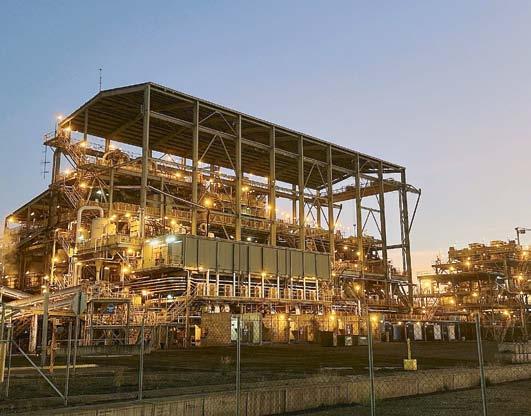
good, bad or indifferent, but we’ve put a lot of effort into making sure the transition across to Whitehaven has been as seamless as we could for you.
“And, if you’re not currently doing business with us then there’s some opportunities here in terms of engaging with us.
“Spending our money locally is a very important feature of the puzzle that we represent.”
Mr Flynn said Whitehaven intended to focus on funding community programs in Blackwater including health, education, childcare and housing.
“Childcare we know is an important thing here, housing we also know is a very important piece of the puzzle here given the expansion in the industry,” he said.
“Our success drives some tightness in the markets, so childcare, housing, what are we going to do to try and alleviate it?
“These are signs of success, which is fan-
tastic, but it does promote some tensions which need to be solved over time.
“We need to play our part in that, not just ourselves, but the other miners in the area all need to play a role.”
Whitehaven has already begun negotiations to offload a 20 per cent stake in the Blackwater mine.
Mr Flynn said with the demand for metallurgical coal forecast to grow by 33 per cent through to 2050, the move was strategic and was prompted by discussions during the Blackwater-Daunia bidding war.
The deal could fetch up to $500m.
“The interest in the (bidding) process also drove significant interest in minority stakes in Blackwater in particular,” Mr Flynn said.
“Many of you see we have embarked on a process of selling a small piece of the mine because we want to form a joint venture at this site…
“The simple answer is it’s a longer-term
objective here – the strategic nature of tying yourself together with the end-using customers not commodity traders.
“We want end-using customers (and) we tie ourselves together with them in premium markets with premium quality customers, that will be the long-term benefit of a joint venture formation.”
Mr Flynn said the company had already had discussions with Blackwater’s Ghungalu people about workplace opportunities, and the Barada Barna people regarding Daunia.
“We’ve had a great meeting... the model here is slightly different to what we’ve applied in Gomeroi territory, but I’m sure we will find a way to make sure that works for everybody,” he said.
“We’ve done great work in that area, and we think there is more we can do, and we would like to bring those efforts up to here and make meaningful contributions to this community and the Central Highlands.”



By Matthew Pearce
Federal Nationals leader David Littleproud says the party has helped spare agriculture industries from a “fresh food tax” but Agriculture Minister Murray Watt has called the rejection of the ALP’s biosecurity protection levy “disappointing”.
The levy was due to be implemented from July 1, 2024, but faced a backlash in the political arena, as well as from primary producers and industry groups such as Agforce and the National Farmers Federation.
Itwouldapplytoimportedgoodsdeemed to pose a biosecurity risk, with the objective to fund biosecurity measures that protect Australia’s agriculture and environment from invasive species, pests, and diseases.
But Mr Littleproud said it would have hurt families at the checkout, with 84 agricultural commodities facing a rise in taxes of
$150 million over three years.
“The biosecurity protection levy will not get the support it needs in the Senate, ensuring Labor’s senseless and terrible tax idea doesn’t come to fruition,” he said.
“The Nationals will always fight for common sense and fight for our regional, rural and remote farming communities. Labor’s terrible tax plan was another attack on our farming industry.”
However, Mr Littleproud, who is also the Member for Maranoa, said he remained concerned Labor had created a sustainable biosecurity funding advisory panel earlier this year, to look at ways farmers could pay more for biosecurity.
“A recent meeting of the panel indicated there was no support for an alternative producer funded contribution. Labor must now come clean and declare it will scrap the levy and scrap the tax from reaching the Senate
and Australian farmers,” he said.
“Labor must also declare that it will leave the current industry-imposed primary industries levies system alone that invests in research and development, marketing and biosecurity.
“The primary industries levies system is critical to the competitiveness, productivity and sustainability of agriculture, and farmers need to know this system will not be used by the Albanese Labor Government to implement a tax.”
In August 2023, the Federal Government announced they would be introducing a new biosecurity levy as of 1 July 2024.
On Wednesday, 8 May at Beef2024, the National Farmers’ Federation and Agforce Queensland had their day of action, calling for this tax to be scrapped, saying the industry was already pulling its weight in this area and the cost would be passed onto consum-
ers. Agriculture Minister Murray Watt said it was “disappointing that the Nationals have teamed up with the Greens to stop a $50 million investment in Australia’s biosecurity, which would defend our farmers against exotic pests and diseases”.
“However, the Albanese Government remains committed to a strong and sustainable biosecurity system,” he said.
“That’s why since being elected in 2022 we have invested more than $1 billion in new biosecurity funding.
“Our changes ensure that for the first time in Australia’s history we now have a sustainable biosecurity funding model to protect our agricultural industry.
“This stands in contrast with David Littleproud’s actions as Agriculture Minister, when he cut biosecurity funding by $100 million a year, putting our farmers’ livelihoods at risk.”
Rabobank’s Rabo Community Fund has partnered with the ‘edu-tainment’ brand ‘George the Farmer’ for the third year to help educate children about where their food and fibre comes from in a fun and engaging way during this year’s National BookWeek – August 17 to 23.
The specialist agribusiness bank – in collaboration with George the Farmer –will award 70 educational institutions –across Australia with a collection of all 13 Australian-made
George the Farmer picture storybooks for their libraries.
Rabobank head of community and client engagement Glenn Wealands said George the Farmer’s “authentic approach and grassroots appeal” resonate remarkably with young readers in rural areas, while also inspiring urban children to develop a deeper understanding and connection to farming.
Mr Wealands said George the Farmer’s aspiration for a world in which children connect with the earth, food and farming aligns seamlessly with the Rabo Community Fund’s central theme of fostering urban-rural connections.
“This is now the third year Rabobank has partnered with George the Farmer to celebrate National Book Week. Each year we have been overwhelmed with applications from educational institutions – including primary schools, kindergartens, pre-schools, early learning centres or childcare centres – from across the country,” he said.
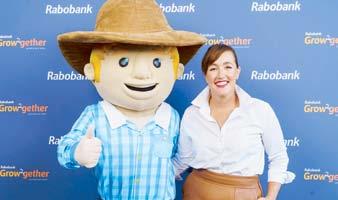
“And to meet this demand, we’re excited to be able to boost the number of complete collections of George the Farmer book bundles available up to 70 bundles, from 50 bundles last year. It has been thrilling to see that level of interest from children, teachers and librarians in learning about agriculture.”
Mr Wealands said the George the Farmer book sets would contribute to enhancing awareness of food and fibre production in schools, potentially igniting interest among children to pursue careers in agriculture.
He said the Book Week initiative was part of an ongoing partnership between the Rabo Community Fund and George the Farmer.
George the Farmer began as an interactive story app in 2015 and founder Simone Kain has since expanded the brand to include virtual reality experiences, music, performances and paddock-to-plate videos available on YouTube and ABC iView, alongside free, curriculum-aligned educational resources.
“These free resources, focusing on STEAM subjects (science, technology, en-
gineering, arts and maths), engage children in agricultural education in a dynamic and interactive manner,” Ms Kain said.
To date, Ms Kain said, over 600,000 children aged four to 10 across Australia have benefited from these free educational resources, covering diverse topics such as apples, chickpeas, wheat, wool, farm safety and dairy.
“In a 2024 survey, 100 per cent of George the Farmer users reported that the platform helped children develop a love for reading and learning, while 98 per cent noted an increase in their knowledge about food and fibre,” she said.
Ms Kain said the George the Farmer team is helping to educate and inspire the next generation – the future leaders, big thinkers, innovators, makers, fixers, creatives, teachers, policy makers and farmers.
“We receive many photos every year of excited kids dressing up as George and Ruby Farmer at their school BookWeek parades. The Rabobank partnership champions agricultural literacy and will not only enable the education of many more kids but inspire them to consider careers in agriculture,” she said.
Applications for the book sets close on Sunday, July 21.
Applications can be made at the following link: https://rabobankaunz.eventsair. com/au-george-the-farmer-book-setcompetition/2024bookweek/Site/Register
Primary producers in the Longreach, Blackall and Emerald districts have the opportunity to expand their knowledge, free of charge, at a series of Rabo Client Council workshops designed to help provide the financial skills critical to managing an agricultural enterprise.
The practical Financial Skills Workshops – providing farmers with an opportunity to both upskill and network – will be held in early August.
The initiative has been spearheaded and funded by food and agribusiness banking specialist Rabobank’s Rabo Client Council, a group of the bank’s farming clients who volunteer their time implementing programs that contribute to the sustainability of rural and regional communities.
Rabobank Northern Queensland and Northern Territory Rabo Client Council member and Aramac-based beef producer Lee-Ann Boyd said the complimentary, interactive workshops would provide practical, hands-on guidance on understanding financial statements and banking require-
ments and explore topics such as taxation versus management accounting, essential business management ratios and understanding key components of a business’s financial profile.
“These workshops aim to provide key financial skills and tools to assist in the effective management of agricultural operations,” she said.
“And it’s exciting to bring the workshops back to these communities.
““Producers who had attended previous Rabobank Financial Skills Workshops have told the bank the information provided is very valuable.”
The workshops – which will be limited to 30 participants each and are not restricted to the bank’s clients – will be delivered by director of Hudson Facilitation, Tony Hudson.
Ms Boyd said the workshops are designed to help close the gap between farming expertise and financial knowledge.
“And while many of our well-educated primary producers have extensive on-farm
experience, understanding the intricacies of financial reporting and banking requirements can still be unfamiliar,” she said.
Ms Boyd said the workshops will explore financial reports, “one of the most useful and underutilised reports for many farming businesses”.
“Module One, presented at the Longreach and Emerald workshops, will help producers gain an understanding of how to read, interpret and use these reports for agricultural businesses,” she said.
“This module provides knowledge and insights for running and managing the dayto-day aspects of an agricultural operation from a financial perspective.
“In the second module, delivered in Blackall, we take an enterprise-focused approach – we will consider cash flow implications of a variety of enterprise choices.
“The module will also focus on preparing annual cash flow budgets. However, participating in the previous session is not a prerequisite to attend.”
Ms Boyd said the workshops are designed to allow couples and family members to attend together.
Rabobank head of relationship management for Northern Queensland and Northern Territory Joe Webb said since the launch of the workshops in 2018, the Rabo Client Councils have extended this valuable learning opportunity to over 4550 farmers across Australia and New Zealand.
“If you’re interested in attending these workshops, keen to meet other leading producers in the agri sector and increase your financial literacy and skills, confirm your place before the courses are fully allocated,” he said.
Workshop dates and locations are:
· Monday, 5 August – 9am – 4pm – Longreach (Module One)
· Tuesday, 6 August – 9am – 4pm – Blackall (Module Two)
· Thursday, 8 August – 9am – 4pm – Emerald (Module One)
To register to participate, visit the Rabobank Australia website.
By Breanna Lloyd
A Bill to phase out live sheep exports by sea on 1 May 2028 has officially been passed only two months after the Albanese Government proposed it, leaving producers worried and animal welfare advocates celebrating victory.
A Federal transition support package of $107 million will be distributed to the Australian sheep industry in support of the Bill, however, many believe it falls millions of dollars short of what is required.
Founding member of the Livestock Collective and Sheep Producers Australia and board member Bindi Murray said farmers would require at least $255 million - $100 million in support for processors, $100 million for the supply chain, $20 million for market development, $15 million for air freight, $10 million for community support and mental health and $10 million for exit payments.
On the contrary, committee chair Meryl Swanson MP said the Bill fulfills the Albanese government’s election promise to end the live export of sheep by sea while providing time and money for the orderly transition of the industry to new avenues of production and trade.
Farming organisations like AgForce have shared their deep concerns about the Bill and have estimated there will be over 3500 families affected more as a direct result.
Former AgForce sheep and wool president and Longreach sheep and cattle breeder Mike Pratt is disgusted with the government’s decision and claims it is not based on factual evidence.
“It is a political decision that will financially and mentally devastate not only sheep producers but everyone involved in the industry,” he said. “The sheep will be transported to the eastern sale yards and the abattoir from Western Australia which will put

pressure on our downward markets.”
According to Meat and Livestock Australia’s 2020 report, 777,798 sheep were exported by sea of which 0.224 per cent died onboard. This report showcased a 15 per cent decrease in mortality rate since 2019.
“On land, sheep farmers accept a three per cent mortality rate from natural causes,” Mr Pratt said. “Due to the Australian standards for the export of livestock, the death rate while onboard is lower than when the livestock are on land.
“From an incident in 2018, the livestock now have 38 per cent more room onboard, decreasing their stress levels, hence acquiring more weight.
“The Australian government put an Exporter Supply Chain Assurance System (ESCAS) in place to ensure the entire supply chain is monitored until the point of slaughter.”
While the spotlight is on the Australian sheep industry, AgForce chief executive of-
ficer Michael Guerin is worried the focus will turn to Australia’s cattle industry.
“The industry has worked extremely hard and has delivered more than what it’s been asked in terms of setting strong animal welfare standards, yet it’s been shut down,” he said.
“It sets a dangerous precedent that essentially says it doesn’t matter if you abide by all the regulations and go above and beyond, political interference overrides everything.”
AgForce Sheep, Wool and Goats president Stephen Tully says the decision shows unjust government processes.
“The Albanese government’s stifled and rushed debate demonstrates Labor’s contempt for farmers and Australia’s agricultural industry,” he said.
“The legislation announcement comes after the Keep the Sheep Petition against the legislation hit over 63,000 signatures on Tuesday 2 July.”
Commodity prices, production and exports have broadly lifted in the first half of the year, with beef the standout performer in Rural Bank’s Australian agriculture mid-year outlook 2024 released recently.
With an overall outlook favourable for the second half of the year, despite some variability across sectors, some cost-of-living relief is also expected to reach beyond the farm gate.
Rural Bank Head of Agribusiness Development Andrew Smith says farmers experienced varied conditions in the first half of the year, but among the many positives in the performance of the six industries analysed – cattle, cropping, dairy, horticulture, sheep and wool – and for Australian agriculture broadly, beef was a highlight.
“Australian beef exports to the US for the year to date were up 85 per cent on last year,” Mr Smith said.
“Elevated export demand from the US –which has seen its lowest herd since 1951 –and key Asian markets is providing stability in beef prices and opportunities for continued export growth moving forward.”
Some relief from cost-of-living pressures is expected for consumers, with Rural Bank’s Outlook report projecting increased fruit and vegetable volumes.
“Some easing in produce pricing for consumers is expected in the coming half, though prices will stay above longer-term averages,” Mr Smith said.
Global freight rates remain elevated and are forecast to persist due to tight vessel supply and strong global demand, but the Out-
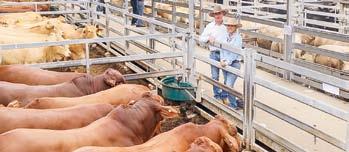
look shows a low Australian dollar has provided support for export markets and has expanded trade access into target markets.
“Exports have been very promising, with India’s recent removal of tariffs on Australian chickpea imports until March 2025. Strong pricing signals are expected to see chickpea growers increase planted area by 80 per cent to 730 thousand hectares - 24 per cent above the 10-year average,” Mr Smith said.
While dry weather persisted across Western and South Australia, with challenging winter crop planting conditions and pasture growth also impacted, the east coast reported much more favourable soil moisture conditions.
“Australian winter crop production should increase nine per cent to 51.3 million tonnes in 2024/25, with increased produc-
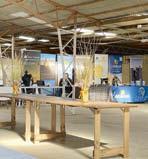
By McKenzie Neal
The GroWQ Innovation Expo is drawing closer, as like-minded figures in the region’s agricultural community come together to share knowledge and learn more about the ever-changing industry.
The expo is across two days in Longreach, with trade displays and stalls along with the speakers being the agenda on Thursday, 25 July, while practical demonstrations will be a prominent focus on Friday, 26 July.
There will be more than 25 speakers and two panels on Thursday, with topics including property security, trough filtration, mustering with drones, and virtual fencing, as well as touching on the use of artificial intelligence in the industry.
The SQNNSW Innovation Hub’s Prue Button is excited about the expo and said preparations were coming together nicely.
“It’s action stations now – we have some good speakers lined up and it is all coming together which is great,” Ms Button said.
“We had 180 people attend last time out, and we are aiming for similar numbers this time around.”
Jack Carmody is a guest speaker on the day, with Ms Button looking forward to what he has to say after doing so much for the industry in other remote settings.
“We have Jack Carmody coming over from Laverton in Western Australia,” she said.
“He is a pretty interesting guy who has done a lot of stuff in really remote settings around adaption of technology and creating systems.”
tion forecast to be met with strong domestic and export demand,” Mr Smith said.
“Further price rises are expected for lamb, adding to gains in the first half of the year. Strong demand from both domestic and export consumers is expected to provide support for increased prices amidst a high supply environment.”
Farm input costs are reported to be easing, says Mr Smith, despite remaining above long-term averages.
“Fertiliser and diesel prices will sit lower than the second half of 2023, with water set to remain affordable, too. A rising unemployment rate is also expected to result in greater seasonal labour availability, particularly in Q4, giving Australian farmers a bit of fixed price relief, all round,” he said.
To view the full analysis in the Australian
All of the topics that will be covered are new, meaning people in attendance will be fixated on the new innovations in the agricultural space.
There is a networking dinner at The Branch which will follow proceedings on the day, giving attendees another opportunity to talk to like-minded individuals about the agriculture space.
There is also an informal meet and greet from 6pm on Wednesday, 24 July at the Chute 1, before the kicking off of proceedings the following day.
The cost is $50 which will get you access to both days, while the networking dinner is an extra $65 per person.
Tickets are still available, with more information available at www.growq. com.au, via email grow@growq.com. au or by phoning 0428 585 663.

The CapRescue team is thrilled to announce the success of this year’s annual Golf Day, raising an impressive $27,000! The event received unprecedented support, with all 18 holes sponsored for the very first time. This milestone highlights the immense community backing for CapRescue’s mission of providing emergency helicopter services across Central Qld.
Asincere thank you goes out to our Major Sponsors—Champ Group, CJ Homes, DC Motors, Chauvel Industrial Services, and 1 Maintenance & Supply.
On Sunday 23rd June, the CapRescue team braved the cold weather to complete two critical rescue missions, marking an extraordinary day for our aeromedical service. Such back-to-back rescues, excluding interhospital transfers, are a rare occurrence and highlight the vital

Your generous support created a wonderful event and made a significant impact on our fundraising.
We also extend our gratitude to our Hole Sponsors, including Blackwoods, Brown and Hurley, Elders Insurance Rockhampton, Farm and Garden Products, Herron Todd White, Hutchinson Builders, JRT Group, Keppel Bay Sailing Club, MM Electrical Rockhampton, Quest Rockhampton, REO Heavy Equipment Repairs, Rockhampton Mini Loads & Truck Hire, and Shanahan Swaffield Partners. Your
role we play in Central Queensland.
The first mission commenced at 3:00AM on Sunday, when our team was tasked to Moranbah.Aman in his early fifties had rolled a heavy tracked machine, resulting in suspected spinal injuries. He was promptly transported by QAS to MoranbahAirport, where he was airlifted to Rockhampton Hospital by Rescue300.
Twelve hours later, our crew was called to Callemondah to assist a young boy

contributions have also gone a long way in supporting our mission. Special thanks to JRT Group for their hole-in-one competition, which boosted our funds raised at the event.
Abig congratulations to DC Motors for taking out the sort after shield for 2024!
Each year, CapRescue performs hundreds of life-saving missions, providing rapid response and critical care to people in remote and rural areas of Central Qld. The money raised helps cover the costs of aircraft maintenance, fuel, equipment,
involved in a motorbike accident. The child had sustained injuries to his lower limbs and possibly his head. Given the challenging terrain, our Rescue Crewman and Doctor were winched down to the scene. The boy was carefully assessed, winched up into the helicopter, and flown to Rockhampton Hospital.
Saturday offered a brief respite with no tasks, allowing our team to rest before the demanding missions on Sunday.

and training, ensuring we can continue to save lives and provide urgent medical care when it is needed most.
We would also like to thank all our participants and volunteers for their enthusiasm and generosity.
Aspecial mention goes to Jun for capturing the candid moments of the day.
We look forward to welcoming everyone back for next year’s event, where we hope to build on this year’s success and continue making a real difference.

